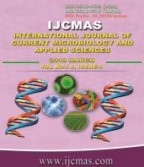


 National Academy of Agricultural Sciences (NAAS)
National Academy of Agricultural Sciences (NAAS)

|
PRINT ISSN : 2319-7692
Online ISSN : 2319-7706 Issues : 12 per year Publisher : Excellent Publishers Email : editorijcmas@gmail.com / submit@ijcmas.com Editor-in-chief: Dr.M.Prakash Index Copernicus ICV 2018: 95.39 NAAS RATING 2020: 5.38 |
Phylogenetic implication in bacterial genomics is important to understanding difficulties such as population history, antimicrobial resistance and transmission dynamics. It has been claimed that partial genome sequences would clarify phylogenetic relationships between isolated organisms, but up to now, no sustaining approach has been proposed to use competently these data. concatenation of sequences of different genes as well as building of consensus trees only consider the few genes that are shared among all organisms. The phylogenetic has been plagued by an apparent state of contradiction since the distorting effects of recombination on phylogeny were discovered more than a decade ago. Total of 100 isolates were isolated wilted tomato plant and rhizosphere soil, amongst ten highly virulent isolates were selected based on morphological, biochemical characteristics and pathogenicity studies, as well as 16S rRNA gene sequencing. The rhizosphere soil samples of healthy tomato plants were used to isolate T. asperellum and P. fluorescens were identified based on morphological and molecular characterization. Total of fifteen isolates among them, ten isolates of R. solanacearum, three isolates of Pseudomonas fluorescens and two isolates of Trichoderma asperellum were isolated from soil samples collected from different locations in Karnataka. The present work demonstrates for the identification of R. solanacearum, P. fluorescens and T. asperellum based on molecular methods based on 16S rRNA sequencing and NCBI BLAST search was performed, multiple sequences alignment and phylogenetic trees were constructed using CLUSTAL X2 2.1 (Windows version). The sequences were deposited to NCBI database.
 |
 |
 |
 |
 |